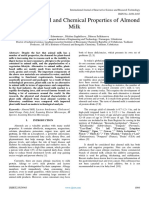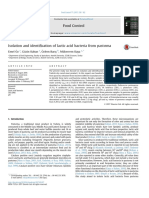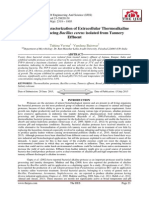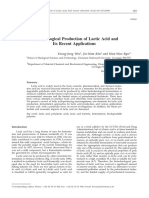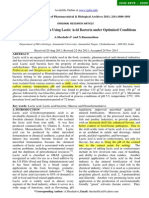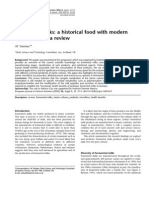Professional Documents
Culture Documents
Isolation of Amylolytic Lactic Acid Bacteria From Cow, Goat and Sheep Milk in Yola Town, Adamawa State, Nigeria
Isolation of Amylolytic Lactic Acid Bacteria From Cow, Goat and Sheep Milk in Yola Town, Adamawa State, Nigeria
Original Title
Copyright
Available Formats
Share this document
Did you find this document useful?
Is this content inappropriate?
Report this DocumentCopyright:
Available Formats
Isolation of Amylolytic Lactic Acid Bacteria From Cow, Goat and Sheep Milk in Yola Town, Adamawa State, Nigeria
Isolation of Amylolytic Lactic Acid Bacteria From Cow, Goat and Sheep Milk in Yola Town, Adamawa State, Nigeria
Copyright:
Available Formats
Volume 9, Issue 4, April – 2024 International Journal of Innovative Science and Research Technology
ISSN No:-2456-2165 https://doi.org/10.38124/ijisrt/IJISRT24APR399
Isolation of Amylolytic Lactic Acid Bacteria from
Cow, Goat and Sheep Milk in Yola Town,
Adamawa State, Nigeria
*Tyokusa, A. G. Danke, I. C.
Microbiology Department Microbiology Department
Joseph Sarwuan Tarka University Modibbo Adama University
(Formerly Federal University of Agriculture), (Formerly Federal University of Technology),
Makurdi, Nigeria. Yola, Nigeria
Corresponding Author: *Tyokusa, A. G.
Abstract:- In this study, lactic acid bacteria (LAB) were Amylase producing lactic acid bacteria known as
isolated from fresh milk samples from cow, sheep, and amylolytic lactic acid bacteria (ALAB) secretes amylases,
goat using MRS agar as a growth medium. which make it easier to hydrolyze and ferment starch into
Lactobacillusplantarum, Lactobacillusacidophilus, lactic acid in a single step (Reddy etal., 2008).The
Lactobacillusfermentum, Enterococcusgallinarum, and manufacture of food additives like organic acids (like lactic
Enterococcusfaecium were the species of LAB that were acid) and enzymes (like alpha amylase) is done in the food
isolated and identified using the Vitek 2 compact system. processing industries using ALAB enzymes (Panda and
While Lactobacillus fermentum, Enterococcus faecium, Ray, 2016). The ALAB produce amylases, which are starch-
and Lactobacillus plantarum were isolated from goat modifying enzymes with a wider range of uses than
milk, Lactobacillus acidophilus, Lactobacillus gallinarum, chemical starch hydrolysis in the food processing sectors
and Lactobacillus plantarum were isolated from cow (Smerilli et al. 2015).Among these essential enzymes in the
milk.However, from sheep milk, only Lactobacillus realm of biotechnology is amylase.From a fungal base,
plantarum and Lactobacillus acidophilus were isolated. amylase appears to have been the first enzyme manufactured
All the isolates were subjected to amylase production test industrially in 1894.In the treatment of digestive diseases, it
using modified MRS media and the results showed that was utilized as a medicinal acid(Shanmugasundaram etal.,
Lactobacillus plantarum, Lactobacillusacidophilus and 2015). According to Sachdev et al (2016), amylase is one of
Lactobacillusfermentum produced amylase while the leading enzymes used in industry from decade and that
Enterococcus gallinarum and Enterococcus faecium did microorganisms such as Bacillus species are the major
not produce amylase. source of production of amylase because of the ease of
availability, manipulation and operation.In contrast to
Keywords:- Milk, LAB, Vitek 2,Amylase and Modified MRS. chemical starch hydrolysis in the starch processing sector, a
wide range of commercially available microbial amylases
I. INRODUCTION now hold potential applications.Among other bacteria that
produce amylase, the most recently found ALAB strain
One of the most important types of bacteria in the food Lactobacillusparacasei B41 was the first amylolytic
industry are the lactic acid bacteria (LAB).People all over representative of the L. casei group(Bhanwar and Gangul,
the world have long consumed them in dairy products, and 2014).
the majority of them are categorized as "generally
recognized as safe" (GRAS) microorganisms because they Milk is theprimary source of nutrition for young
are non-pathogenic, appropriate for industrial and mammals (including breastfed human infants) before they
technological processes, tolerant of bile and acid, and are able to digest solid food (Van Winckel etal., 2011). The
capable of producing antimicrobial substances (Shehata et primary players in milk fermentation are lactic acid bacteria,
al., 2016).Pediococcus, Enterococcus, Lactobacillus, which work with amylase and other produced enzymes to
Streptococcus, Leuconostoc, and other bacteria are among convert lactose to lactic acid. This increased acidity makes
the cocci and bacilli in the LAB group (Mazzoli et al., the growth conditions of microorganisms other than LAB
2014).Application areas for lactic acid bacteria (LAB) increasingly unfavourable (Fernandez et al., 2015).
include food, agriculture, and medicine (Bintsis,
2018).Furthermore, lactic acid bacteria produce a variety of Considering cattle, sheep and goats rearing as major
enzymes, including lipases, ureases, peptidases, amylases, occupationinAdamawa state of Nigeria, fresh milk is always
and proteases. in abundant supply. Therefore, isolating amylase producing
lactic acid bacteria from cow, sheep and goat milk in the
state will create an avenue for exploring and harnessing the
available resources within the state. Consequently, the aim
IJISRT24APR399 www.ijisrt.com 1018
Volume 9, Issue 4, April – 2024 International Journal of Innovative Science and Research Technology
ISSN No:-2456-2165 https://doi.org/10.38124/ijisrt/IJISRT24APR399
of this research work was to isolate and identify the amylase Manganese sulphate-0.05 all g/L/, pH-6.5 at 250C) (TITAN
producing lactic acid bacteria from cow, goat and sheep BIOTECH LTD India) for 24 to 48 hours at room
milk from Yola, Adamawa state of Nigeria. temperature (30-370C). Pure isolates were obtained by sub-
culturing a representative sample of distinct colonies spotted
II. METHODOLOGY on MRS agar.The bacteria isolates were identified using the
Vitek 2 compact system (BIOMERIEUX, France) in
A. Sample Collection, Isolation and Identification of addition to the catalase test and microscopic identification.
Bacteria Isolates
Five samples of fresh cow, goat, and sheep milk each B. Detection of Amylase Activity
were collected in sterile containers, transported to the In order to detect amylase activity, the isolated lactic
laboratory, and left for a 24-hour fermentation period. In acid bacteria were grown on modified MRS media
total, fifteen samples were obtained.Serial dilutions were containing 0.5% peptone, 0.7% yeast extract, 0.2% NaCl,
made for all the samples and appropriate dilutions (10-5 to 2% starch, and 1.5% agar. Following a 24-48-hour
10-9) inoculated on MRS agar (Dextrose-20, Agar 12., incubation period at 37°C, Gram's iodine solution (iodine:
Proteose peptone-10, Beef extract-10, Yeast extract-5, 0.2%, KI: 0.4%, distilled water: 100 mL) was added and the
Sodium acetate-5, Ammonium citrate-2, Dipotassium results were monitored (Madhavet al., 2011).
phosphate-2, Tween 80-1, Magnesium sulphate-0.10 and
III. RESULTS
Results of Bacteria Isolates from Cow, Goat and Sheep Milk
Table 1: Catalase Test and Microscopic Identification of the Isolates
S/N ISOLATE CODE CATALASE TEST GRAM REACTION SHAPE
1 C1 _ + Rods
2 C2 _ + Rods
3 C3 _ + Cocci
4 G1 _ + Rods
5 G2 _ + Rods
6 G3 _ + Cocci
7 S1 _ + Rods
8 S2 _ + Rods
KEY: C=Cow Milk Isolate, S= Sheep Milk Isolate, G= Goat Milk Isolate + = Positive, - = Negative
Table 2: Lactic Acid Bacteria Identified using the Vitek 2 Compact System from the Milk Samples
S/No Source Lactic Acid Bacteria
1 C1 Lactobacillus fermentum
2 C2 Lactobacillus plantarum
3 C3 Enterococcus gallinarum
4 G1 Lactobacillus plantarum
5 G2 Lactobacillus fermentum
6 G3 Enterococcus faecium
7 S1 Lactobacillus acidophilus
8 S2 Lactobacillus plantarum
KEY: C = Cow Milk, G = Goat Milk and S = Sheep Milk
IJISRT24APR399 www.ijisrt.com 1019
Volume 9, Issue 4, April – 2024 International Journal of Innovative Science and Research Technology
ISSN No:-2456-2165 https://doi.org/10.38124/ijisrt/IJISRT24APR399
Results of Lactic Acid Bacteria That Produce Amylase
Plate 1: Detection of Lactic Acid Bacteria's Amylase Activity on a Modified MRS Agar Plate
Table 3: Amylase Producing Lactic Acid Bacteria
S/N ISOLATE CODE ISOLATE NAME AMYLASE PRODUCTION
1 C1 Lactobacillus fermentum +
2 C2 Lactobacillus pantarum +
3 C3 Enterococcus gallinarum -
4 G1 Lactobacillus plantarum+
5 G2 Lactobacillus fermentum+
6 G3 Enterococcus faecium-
7 S1 Lactobacillus acidophilus+
8 S2 Lactobacillus plantarum+
KEY: C = isolate from cow milk, G = Isolate from goat milk. S = Isolate from sheep milk,
(+) = produce amylase and (-) = do not produce amylase
IV. DISCUSSION goat milk that are Gram positive. Raw cow milk wasused to
isolate and identify LAB genera, including Lactobacillus,
Based on this finding, the bacteria isolated were Gram Lactococcus, Leuconostoc, Pediococcus, Streptococcus, and
positive and catalase negative.Altogether,a total of six rods Bifidobacterium species(Fesseha etal., 2021). Similarly, the
and two cocci bacteria were isolated (Table 1).The Vitek 2 raw cow milk was also used to isolate the LAB
compact system was used to identify the bacteria isolates namely;Enterococcus, Lactobacillus, Leuconostoc,
(Table 2).The isolates identified were Streptococcus, Lactococcus, and Pediococcus species
Lactobacillusfermentum, Lactobacillusplantarum, (Wassie and Wassie, 2016).Guessas and Kihal (2004), also
Lactobacillusacidophilus, Enterococcusgallinarum and isolated LAB namely Lactococcus sp,
Enterococcusfaecium.L. plantarum was found in all the Streptococcusthermophilus, Leuconostoc sp,
three milk samples while L. fermentum were found in goat Lactobacilluscurvatus, L. helviticus, L. plantarum,L. reuteri,
and sheep milk. L. acidophilus was however, found only in L. casei, L. brevis, L. bulgaricus, L. paracasei and L.
cow milk sample.Similarly, Enterococcusgallinarum was caidophilus from goat milk.
present in cow milk only while Enterococcusfaecium was
isolated only from goat milk.All the isolates are members of The Lactobacilli genera; Lactobacilli plantarum, L.
the lactic acid bacteria (LAB). This agrees with Agagunduz pentosus, L. delbrueckii, L. helveticus, and L. paracasei-
etal (2021), who reported that, a variety of live lactic acid associated with a fermented goat milk product from
bacteria species can be found in fermented dairy Tajikistan were isolated byCho et al, (2018).In contrast,
products.Tyokusa and Owuama (2023), also isolated lactic Lactobacillus plantarum YN.1.3, a lacticacidbacterium, was
acid bacteria(Enterococcusgallinarum and isolated by Yelnetty et al (2020), from goat milk.According
Enterococcusfaecium) and additional bacteria from cow and to Chen etal(2020), Hu sheep milk was used to isolate
IJISRT24APR399 www.ijisrt.com 1020
Volume 9, Issue 4, April – 2024 International Journal of Innovative Science and Research Technology
ISSN No:-2456-2165 https://doi.org/10.38124/ijisrt/IJISRT24APR399
Lactococcuslactis, Leuconostoc lactis, and a 97-amino acid starch-binding domain (SDB) (Wang et al.,
Sphingomonas.Lactobacillusplantarum, Lactobacillus 2006). A 954 amino acid protein with an open reading frame
rhamnosus, Lactobacillus acidophilus, and of 2862 bp was found to be encoded by the whole nucleotide
Bacillusshackletonii are the four species of lactic acid sequence of the LactobacillusamylovorusamyA gene(Giraud
bacteria (LAB) that were isolated from sheep milk and and Cuny, 1997).
identified using physiological, biochemical, and 16S rRNA
sequencing study (Patil et al., 2019). V. CONCLUSION
All the Lactobacillus species isolated produced Fresh milk from cows, sheep, and goats obtained from
amylase while Enterococcus species did not produce Adamawa State, Nigeria, like any other place,is a good
amylase (Table 3).Amylolytic Lactobacillus species have source of amylase producing lactic acid bacteria such as
been isolated from milk and other sources. Lee et al (2006), Lactobacillusfermentum, Lactobacillusplantarum, and
isolated L. acidophilus and L. fermentum with high amylase Lactobacillusacidophilus. The importance of this enzyme in
activity from intestinal contents of pigs. Also, South African food and other industries cannot be over emphasized. It is
barley was used to isolate strains of Lactobacillus therefore important to harness the readily available milk in
plantarum that producedα-amylase (Hattingh et al., Adamawa state for the commercial production of the
2015).Likewise, from traditional fermented Dadih, Elida amylase enzyme.
etal (2022), isolated the lactic acid bacteria that produce
amylase: Lactobacillusparacasei subsp paracasei mL3, REFERENCES
Lactobacillusplantarum mH4, Lactococcuslactis subsp
lactis Mh6, Lactobacillusplantarum Mh8, and [1]. Agagunduz, D., Yilmaz, B., Sahin, T. O., Gunesliol,
Lactobacillusparacasei subsp paracasei Ml14. B. E., Ayten, S., Russo, P., Spano, G., Rocha, J. M.,
Barkiene, E. and Ozogul, F. (2021). Diary Lactic
The amylase activities of the lactic acid bacteria Acid Bacteria and Their Potential Function in
isolates,Lactobacillusfermentum, Lactobacillusplantarum Dietetics: The Food-Gut-Health Axis. Foods
and Lactobacillusacidophilus is shown on plate 1.Amylases 10(12):3099 doi:10.3390/foods10123099
are a class of enzymes that break down starch into simple [2]. Akinfemiwa, O., Zubair, M. and Muniraj, T. (2023).
sugars, and a wide range of species produced these proteins Amylase. In: StatPears publishing.
(Gomez-Villegas et al., 2021).Amylases' main function is to [3]. Bhanwar, S. and Ganguli, A. (2014). α-amylase and
hydrolysed the glycosidic bonds that hold starch molecules β-galactosidase production on potato starch waste by
together, converting complicated carbohydrates into simpler Lactococcuslactis subsp. lactis isolated from pickled
sugars. yam. Journal of Scientific and Industrial Research73:
324–330.
Alpha, beta, and gamma amylases are the three [4]. Bintsis, T. (2018). Lactic acid bacteria: their
primary classes of amylases, and they all target different applicationsin foods. Journal ofBacteriology and
parts of the carbohydrate molecule(Akinfemiwa etal., Mycology 6(2:89-94 DOI:
2023).Thus, the degradation of the starch present in the 10.15406/jbmoa.2018.06.00182
medium resulting in the clear zones (the loss of blue colour [5]. Chen, T., Wang, L., Li, Q. et al (2020). Functional
of iodine-starch complex) around the colonyof each isolate probiotics of lactic acid bacteria from Hu sheep
as seen on plate 1is as a result of the amylases produced by milk. BMC Microbiology20, 228
the three LAB isolates.By analyzing the halo zone https://doi.org/10.1186/s12866-020-01920-6
surrounding the colonies, which had a diameter of 0.9 mm [6]. Cho, G. S., Cappello, C., Schrader, K., Fagbemigum,
and 1.23 mm, Padmavathi et al (2018), found that O., Oguntoyinbo, F. A., Csovcsics, C., Rösch, N.,
Lactobacillusfermentum and Lactobacillus species Kabisch, J., Neve, H., Bockelmann, W., Briviba, K.,
G3_4_1TO2, isolated from various materials such as milk, Modesto. M., Cilli, E., Mattarelli, P. and Franz, C.
curd, and bovine colostrum, produced amylase enzyme. M. A. P. (2018). Isolation and Characterization of
Lactic Acid Bacteria from Fermented Goat Milk in
Garcia-Cano et al (2020),identified endo and Tajikistan. Journal of Microbiology and
exoamylases as among the enzymes that break down starch. Biotechnology 28(11)
The inner section of amylose and amylopectin contains α- [7]. Elida, M., Agustina, A., Ermiati, E. and Desminarti,
1,4 glycosidic linkages that endoamylases cleave to release S. (2022). Isolate Characterization and Amylolytic
oligosaccharides and dextrin as α-anomeric derivatives.Like Properties of Lactic Acid Bacteria from Traditional
glucoamylase or α-glucosidase, exoamylases can cleave the Fermented Dadih. IOP Conference Series: Earth
α-1,4 and α-1,6 bonds of the exterior glucose residues, and Environmental Science. Doi: 10.1088/1755-
releasing glucose as the end product. 1315/1097/1/012025
[8]. Fernandez, M., Hudson, J. A., Korpela, R. and de los
One important feature of LAB that contributes to the Reyes-Gavilan, C. G. (2015). Impact on Human
fermentation of starch into lactic acid is its amylolytic Health of Microorganisms Present in Fermented
activity.The primary cause of the amylolytic activity in Diary Products: An Overview. BioMed Research
ALAB is the alpha-amylase (amyA) genes. The amyA gene International doi: 10.1155/2015/412714
has 1746 base pairs, a 459-amino acid catalytic domain, and
IJISRT24APR399 www.ijisrt.com 1021
Volume 9, Issue 4, April – 2024 International Journal of Innovative Science and Research Technology
ISSN No:-2456-2165 https://doi.org/10.38124/ijisrt/IJISRT24APR399
[9]. Fesseha, H., Taye, Y., Degu, T. and Mathewos, M. [21]. Reddy, G., Altaf, M., Naveena, B. J., Venkatteshwar,
(2021). Isolation and Identification of Lactic Acid M. and Kumar, E. V. (2008). Amylolytic bacteria
Bacteria from Cow Milk and Milk Products. The lactic acid fermentation-a review. Biotechnology
Scientific World Journal. Advances 26:22-33
[10]. Garcia-Cano, I., Rocha-Mendoza, D., Kosmerl, E., [22]. Sachdev, S., Ojha, S. and Mishra, S. (2016). Bacillus
Zhang, L. and Jimenez-Flores, R. (2020). Technically Spp. Amylase: Production, Isolation,
relevant enzymes and proteins produced by LAB Characterization and Its Application. International
suitable for industrial and biological activity. Journal of Applied Sciences and Biotechnology.
Applied Microbiology and Biotechnology Doi.10.3126/ijasbt.v4i1.14574
doi.org/10.1007/s00253- 019-10322-2 [23]. Shanmugasundaram, S. Eswar, A., Mayavu, P.,
[11]. Giraud, E. and Cuny, G. (1997). Molecular Surya, M. and Anbarasu, R. (2015). Screening and
characterization of the alpha-amylase genes of Identification of Amylase Producing Bacteria from
Lactobacillusplantarum A6 and Lactobacillus Marakkanam Saltpan Environment, Tamil
amylovorus reveals an unusual 3’ end structure Nadu, India. Asian Journal of Biomedical and
with direct tandem repeats and suggests a common Phamarceutical Sciences
evolutionary origin. Gene. doi:10.1016/s0378- [24]. Shehata, M. G., El Sohaimy, S. A. El-Sahn, M. A.
1119(97)00309-0 and Youssef, M. M. (2016). Screening of isolated
[12]. Gomez-Villegas, P., Vigara, J., Romero,L., Gotor, potential probiotic lactic acid bacteria for cholesterol
C., Raposo, S., Goncalves, B. and Leon, R. (2021). lowering property and bile salt hydrolase activity.
Biochemical Characterization of the Amylase Annals of Agricultural Science. 6(1):65–75.
Activity from the New Haloarchaeal Strain [25]. Smerilli, M., Neureiter, M., Wurz, S., Haas, C.,
Haloarcula sp. HS Isolated from Odiel Marshlands. Fruhauf, S. and Fuchs, W. (2015). Direct
Biology 10(4):337 doi:10.3390/biology10040337 fermentation of potato starch and potato residues to
[13]. Guessas, B. and Kihal, M. (2004). Characterization lactic acid by Geobacillus stearothermophilus under
of lactic acid bacteria isolated from Algerian arid non-sterile conditions. Journal of Chemical
zone raw goat milk. African Journal of Technology and Biotechnology. 90(4) 648-657
Biotechnology 3(6). [26]. Tyokusa, A. G. and Owuama, C. I. (2023).
[14]. Hattingh, M., Alexander, A., Meijering, I., van Bacteriocins Production Potentials of Some Gram
Reenan, C. A. and Dicks, L. M. T. (2015). Positive Cocci Bacteria Isolated from Milk and
Amylolytic strains of Lactobacillusplantarum Other Food Sources. Current Trends on
isolated from barley. African Journal of Biotechnology and Microbiology 3(4)DOI:
Biotechnology 14(4). 10.32474/CTBM.2023.03.000172
[15]. Lee, H, S., Gilliland, S. E. and Carter, S. (2006). [27]. Van Winckel, M. Velde, S. V., De Bruyne, R. and
Amylolytic Cultures of Lactobacillusacidophilus: Biervliet, S. (2011). “Clinical Practice”. European
Potential Probiotics to Improve Dietary Starch Journal of Pediatrics 170(12): 1489-1494
Utilization. Journal of Food Science 66(2):338-344 doi:1007/s00431-011-1547
[16]. Madhav, K., Verma, S. and Tanta, R. (2011). [28]. Wang, N. Zhang, T., Wang, Q., Liu, J., Wang, H.,
Isolation of amylase producing Bacillus species from Xue, Y. and Ma, Y. (2006). Gene cloning and
soil sample of different regions in Dehradun and to characterization of a novel alpha-amylase from
check the effect of pH and Temperature on their alkaliphilic Alkalimonas amylolytica. Biotechnology
amylase activity. Journal of Pharmaceutical and Journal 1(11): 1256-65. Doi:10.1002/biot.200600098
Biomedical Sciences 12(12) [29]. Wassie, M. and Wassie, T. (2016). Isolation and
[17]. Mazzoli, R., Bosco, F., Mizrahi, I., Bayer, E. A. and Identification of Lactic Acid Bacteria from Raw Cow
Pessione, E. (2014). Towards lactic acid bacteria- Milk. International Journal of Advanced Research in
based biorefineries. Biotechnology Advances 32: Biological Sciences 3(8)
1216–1236. DOI:10.1016/j.biotechadv.2014.07.005 [30]. Yelnetty, A. Purwadi, Ekawati, T. T. (2020).
[18]. Panda, S. H. and Ray, R. C. (2016). Amylolytic Indigenous Lactic Acid Bacteria Isolated from
Lactic Acid Bacteria, Microbiology and Food Spontaneously Fermented Goat Milk as Potential
Technological Interventions in Food Fermentation In Probiotics. Pakistan Journal of Biological Sciences
book: Fermented foods. Doi:10.1201/b19872-9 23(7):883-890
[19]. Padmavathi, T., Bhargari, R., Rao Priyanka, P.,
Niranjan, N. R. and Pavitra, P. V. (2018). Screening
of potential probiotic lactic acid bacteria and
production of amylase and its partial purification.
Journal of Genetic Engineering and Biotechnology
16(2): 357-362 doi: 10.1016/j.jgeb.2018.03.005
[20]. Patil, A.,Disouza, J. and Pawar, S. (2019).Shelf-life
stability of encapsulated lactic acid bacteria isolated
from sheep milk thrived in different milk as natural
media. Small Ruminant Research vol 170:19-25
IJISRT24APR399 www.ijisrt.com 1022
You might also like
- Microbiological Quality Control of Soymilk Sold in Kogi StateDocument5 pagesMicrobiological Quality Control of Soymilk Sold in Kogi StateIJAR JOURNALNo ratings yet
- Vulvovaginal InfectionDocument37 pagesVulvovaginal Infectionmadmax500No ratings yet
- Influence of Probiotic Bacteria Isolated From Camels' Milk On The Physicochemical Properties of Camels' Milk Stirred YoghurtDocument7 pagesInfluence of Probiotic Bacteria Isolated From Camels' Milk On The Physicochemical Properties of Camels' Milk Stirred YoghurtMarwa ElgendyNo ratings yet
- Ajol File Journals - 413 - Articles - 203082 - Submission - Proof - 203082 4921 508128 1 10 20210126Document12 pagesAjol File Journals - 413 - Articles - 203082 - Submission - Proof - 203082 4921 508128 1 10 20210126iqra sadiqNo ratings yet
- Guetouache Et Guessas, 2015Document8 pagesGuetouache Et Guessas, 2015sofianehadji47No ratings yet
- Detection and Isolation of Lactic Acid Bacteria and Its Use As Local Starters in Syrian Akawi Cheese ProcessingDocument6 pagesDetection and Isolation of Lactic Acid Bacteria and Its Use As Local Starters in Syrian Akawi Cheese ProcessingMonyet...No ratings yet
- Ismail 2018 IOP Conf. Ser. Earth Environ. Sci. 130 012019Document9 pagesIsmail 2018 IOP Conf. Ser. Earth Environ. Sci. 130 012019Richard OktavianNo ratings yet
- ArtculomarthaDocument11 pagesArtculomarthaDiana CanabNo ratings yet
- UCHIDA Et Al-2007-Animal Science JournalDocument10 pagesUCHIDA Et Al-2007-Animal Science JournalZolboo TsolmonbaatarNo ratings yet
- Β-galactosidase Biotechnological Applications in Food ProcessingDocument15 pagesΒ-galactosidase Biotechnological Applications in Food Processingmeyajoh806No ratings yet
- Study of Physical and Chemical Properties of Almond MilkDocument4 pagesStudy of Physical and Chemical Properties of Almond MilkInternational Journal of Innovative Science and Research TechnologyNo ratings yet
- Jmbfs 1181 YalcinDocument5 pagesJmbfs 1181 YalcinvalentinaNo ratings yet
- 904 Guetouache Et AlDocument9 pages904 Guetouache Et AlsamirNo ratings yet
- RCBS EdiFachrialDocument10 pagesRCBS EdiFachrialHeppy Setya primaNo ratings yet
- Productionand Optimizationof Hyaluronic AcidDocument12 pagesProductionand Optimizationof Hyaluronic AcidPAULA ANDREA QUICENO GIRALDONo ratings yet
- 1 s2.0 S0141813020308515 MainDocument7 pages1 s2.0 S0141813020308515 MainAlvaro Matus CNo ratings yet
- Isolation of Lactic Acid Producing Bacteria and Production of Lactic Acid From IsolatesDocument6 pagesIsolation of Lactic Acid Producing Bacteria and Production of Lactic Acid From IsolatesNIET Journal of Engineering & Technology(NIETJET)No ratings yet
- 1 s2.0 S0168160523003057 MainDocument8 pages1 s2.0 S0168160523003057 MainDANIELA OSORIO MURILLEJONo ratings yet
- Jurnal DipakaiDocument5 pagesJurnal DipakaiMar'atus SyarifahNo ratings yet
- Article1380184646 - Tatsadjieu Et AlDocument8 pagesArticle1380184646 - Tatsadjieu Et AlNadz BancayaNo ratings yet
- Ufc KefirDocument7 pagesUfc KefirDaniel InzunzaNo ratings yet
- Isolation and Characterization of Extracellular Thermoalkaline Protease Producing Bacillus Cereus Isolated From Tannery EffluentDocument7 pagesIsolation and Characterization of Extracellular Thermoalkaline Protease Producing Bacillus Cereus Isolated From Tannery EffluenttheijesNo ratings yet
- Alvarez Et Al 2010 Kinetic Analysis and Mathematical Modeling of Growth and Lactic Acid Production of Lactobacillus Casei VarDocument9 pagesAlvarez Et Al 2010 Kinetic Analysis and Mathematical Modeling of Growth and Lactic Acid Production of Lactobacillus Casei VarClaudio Alarcón GarcíaNo ratings yet
- Watanabe 2008Document14 pagesWatanabe 2008Namuun TsetsegNo ratings yet
- Issn 0189-0514 J. Anim. Prod. Res. (2016) 28 (1) :78-83Document6 pagesIssn 0189-0514 J. Anim. Prod. Res. (2016) 28 (1) :78-83ddallaocciNo ratings yet
- Artículo EnzimasDocument15 pagesArtículo EnzimasMauricio Esteban Mosquera JordánNo ratings yet
- Biotechnological Production of Lactic Acid and ItsDocument11 pagesBiotechnological Production of Lactic Acid and ItsMathilda PasaribuNo ratings yet
- Artículo Ácido LácticoDocument7 pagesArtículo Ácido LácticoXavier Castro CentenoNo ratings yet
- Bioscientific Review (BSR)Document11 pagesBioscientific Review (BSR)UMT JournalsNo ratings yet
- AMYLASEENZYMEDocument7 pagesAMYLASEENZYMEChitrikaNo ratings yet
- Fermented Sheep S Milk Enriched in Gamma Amino Butyric Acid GABA by 2022 LDocument9 pagesFermented Sheep S Milk Enriched in Gamma Amino Butyric Acid GABA by 2022 LEmerald Falah BrayogaNo ratings yet
- Development of Cultivation Medium For High Yield Kefiran Production by Lactobacillus KefiranofaciensDocument6 pagesDevelopment of Cultivation Medium For High Yield Kefiran Production by Lactobacillus KefiranofaciensPaula Andrea QuicenoNo ratings yet
- jfnr06 2 p047 054 Mlichova PDFDocument8 pagesjfnr06 2 p047 054 Mlichova PDFTatum NilamsariNo ratings yet
- Biocatalysis and Agricultural Biotechnology: SciencedirectDocument9 pagesBiocatalysis and Agricultural Biotechnology: SciencedirectusepNo ratings yet
- Arce MainDocument9 pagesArce MainDeavid PrietoNo ratings yet
- Research Article Bacillus SubtilisDocument10 pagesResearch Article Bacillus SubtilisDương Nguyễn Thùy DungNo ratings yet
- Screening of Lactic Acid Bacteria Strains IsolatedDocument8 pagesScreening of Lactic Acid Bacteria Strains Isolatedluisd.parraNo ratings yet
- Saccharomyces Cerevisiae: A Simple Laboratory Exercise For Ethanol Production by Immobilized Bakery YeastsDocument3 pagesSaccharomyces Cerevisiae: A Simple Laboratory Exercise For Ethanol Production by Immobilized Bakery Yeastsmaraki998No ratings yet
- International Journal of Food Microbiology: ArticleinfoDocument8 pagesInternational Journal of Food Microbiology: ArticleinfoJessica BalganiNo ratings yet
- 4 - Choubane S., Khelil O. Et Cheba B. 2015, African Journal of BiotechnologyDocument6 pages4 - Choubane S., Khelil O. Et Cheba B. 2015, African Journal of BiotechnologyOmar KHELILNo ratings yet
- Ciência e Tecnologia de Alimentos 0101-2061: IssnDocument5 pagesCiência e Tecnologia de Alimentos 0101-2061: IssnMonyet...No ratings yet
- Preliminary Characterization of BacterioDocument9 pagesPreliminary Characterization of Bacteriomanuomar35No ratings yet
- Lignocelluloytic Activities and Composition of Bacterial Community in The Camel RumenDocument14 pagesLignocelluloytic Activities and Composition of Bacterial Community in The Camel Rumenebrahim sabraNo ratings yet
- Growth Studies of Potentially Probiotic Lactic Acid Bacteria in Cereal-Based SubstratesDocument9 pagesGrowth Studies of Potentially Probiotic Lactic Acid Bacteria in Cereal-Based SubstratesSjjshahaNo ratings yet
- FRFST 02 894761Document9 pagesFRFST 02 89476115041168No ratings yet
- Production and Partial Characterization of Extracellular Amylase Enzyme From Bacillus Amyloliquefaciens P-001Document12 pagesProduction and Partial Characterization of Extracellular Amylase Enzyme From Bacillus Amyloliquefaciens P-001Matache GabrielaNo ratings yet
- Produccion de Acido Lactico A Partir de Suero de LDocument7 pagesProduccion de Acido Lactico A Partir de Suero de LJulieta AhumadaNo ratings yet
- Prevention of Bread Mould Spoilage Using Lactic AcDocument6 pagesPrevention of Bread Mould Spoilage Using Lactic AcAna LuizaNo ratings yet
- 1 s2.0 S0960852423010222 MainDocument10 pages1 s2.0 S0960852423010222 MainDANIELA OSORIO MURILLEJONo ratings yet
- Tumuramye Yonah - PresentationDocument18 pagesTumuramye Yonah - PresentationRONALD BST(C)2023No ratings yet
- MAB - 2018 A PDFDocument6 pagesMAB - 2018 A PDFAmriNo ratings yet
- Fermentation 05 00049 v2Document9 pagesFermentation 05 00049 v2Safira CANo ratings yet
- Mycotoxins in Milk Occurrence and Evaluation of CeDocument16 pagesMycotoxins in Milk Occurrence and Evaluation of CeBorja Muñoz SolanoNo ratings yet
- Production and optimization of α-amylase from thermo-halophilic bacteria isolated from different local marine environmentsDocument9 pagesProduction and optimization of α-amylase from thermo-halophilic bacteria isolated from different local marine environmentsDr. P.V.Kamala KumariNo ratings yet
- Food ScienceDocument9 pagesFood ScienceBambang Eko Teguh wNo ratings yet
- Penelitian PDFDocument10 pagesPenelitian PDFFridho SetyawanNo ratings yet
- 44 163 PDFDocument10 pages44 163 PDFFridho SetyawanNo ratings yet
- Optimization and Cholesterol Lowering Activity of Exopolysaccharide From Lactiplantibacillus Paraplantarum NCCP 962Document16 pagesOptimization and Cholesterol Lowering Activity of Exopolysaccharide From Lactiplantibacillus Paraplantarum NCCP 962nur rohmanNo ratings yet
- Impact of Cocoa Processing Technologies in Free FaDocument7 pagesImpact of Cocoa Processing Technologies in Free FaBunayya Rabbika Firly0% (1)
- Non-Food Applications of Milk Components and DairyDocument23 pagesNon-Food Applications of Milk Components and DairyAldomon2224 SimonNo ratings yet
- Assessment of Integrated Poultry Manure and Synthetic Fertilizer Effects on Maize (Zea mays) Growth and Soil Properties: A Study from Bayero University, KanoDocument15 pagesAssessment of Integrated Poultry Manure and Synthetic Fertilizer Effects on Maize (Zea mays) Growth and Soil Properties: A Study from Bayero University, KanoInternational Journal of Innovative Science and Research Technology100% (1)
- Seasonal Variation and Distribution Patterns of Endophytic Community in Withania SomniferaDocument7 pagesSeasonal Variation and Distribution Patterns of Endophytic Community in Withania SomniferaInternational Journal of Innovative Science and Research TechnologyNo ratings yet
- Utilizing Chicken Eggshells and Waste Glass Powder as Cement Fillers for Environmental StabilityDocument6 pagesUtilizing Chicken Eggshells and Waste Glass Powder as Cement Fillers for Environmental StabilityInternational Journal of Innovative Science and Research TechnologyNo ratings yet
- Personal Capabilities of The Non-Teaching Personnel and Client SatisfactionDocument8 pagesPersonal Capabilities of The Non-Teaching Personnel and Client SatisfactionInternational Journal of Innovative Science and Research TechnologyNo ratings yet
- Transforming Challenges to Victories: An Inquiry on Transformational Leadership of School Leaders in the Public Elementary SchoolsDocument54 pagesTransforming Challenges to Victories: An Inquiry on Transformational Leadership of School Leaders in the Public Elementary SchoolsInternational Journal of Innovative Science and Research TechnologyNo ratings yet
- The Influence of Continuance Commitment on Job Satisfaction of Barangay Health Workers in Malaybalay City, BukidnonDocument14 pagesThe Influence of Continuance Commitment on Job Satisfaction of Barangay Health Workers in Malaybalay City, BukidnonInternational Journal of Innovative Science and Research TechnologyNo ratings yet
- Intelligent Clinical Documentation: Harnessing Generative AI For Patient-Centric Clinical Note GenerationDocument15 pagesIntelligent Clinical Documentation: Harnessing Generative AI For Patient-Centric Clinical Note GenerationInternational Journal of Innovative Science and Research TechnologyNo ratings yet
- Exploring The Potential Advantages of Traditional Therapies in Autoimmune Blistering Illnesses: A Comprehensive Review and Analysis, ResearchDocument12 pagesExploring The Potential Advantages of Traditional Therapies in Autoimmune Blistering Illnesses: A Comprehensive Review and Analysis, ResearchInternational Journal of Innovative Science and Research TechnologyNo ratings yet
- Meta Land: Redefining Virtual Communities Through Centralized Governance, Inclusivity and InnovationDocument5 pagesMeta Land: Redefining Virtual Communities Through Centralized Governance, Inclusivity and InnovationInternational Journal of Innovative Science and Research TechnologyNo ratings yet
- Solar Based Multilevel Inverter F o R BLDC Motor DriveDocument8 pagesSolar Based Multilevel Inverter F o R BLDC Motor DriveInternational Journal of Innovative Science and Research TechnologyNo ratings yet
- Skin Disease Detection and Remedial SystemDocument7 pagesSkin Disease Detection and Remedial SystemInternational Journal of Innovative Science and Research TechnologyNo ratings yet
- Design and Development of Multi-Featured Medical StretcherDocument4 pagesDesign and Development of Multi-Featured Medical StretcherInternational Journal of Innovative Science and Research TechnologyNo ratings yet
- EmoConnect: Nurturing Trust and Relationship Bonds in Alzheimer's ConversationsDocument3 pagesEmoConnect: Nurturing Trust and Relationship Bonds in Alzheimer's ConversationsInternational Journal of Innovative Science and Research TechnologyNo ratings yet
- Unlocking Sentiments: Enhancing IOCL Petrol Pump ExperiencesDocument8 pagesUnlocking Sentiments: Enhancing IOCL Petrol Pump ExperiencesInternational Journal of Innovative Science and Research TechnologyNo ratings yet
- Smart and Secure Home With ChatbotDocument9 pagesSmart and Secure Home With ChatbotInternational Journal of Innovative Science and Research TechnologyNo ratings yet
- Preparation and Identification of Magnetic Iron Nanoparticle Based On A Natural Hydrogel and Its Performance in Targeted Drug DeliveryDocument17 pagesPreparation and Identification of Magnetic Iron Nanoparticle Based On A Natural Hydrogel and Its Performance in Targeted Drug DeliveryInternational Journal of Innovative Science and Research TechnologyNo ratings yet
- Development of Smart Ground Fault Location Model For Radial Distribution SystemDocument14 pagesDevelopment of Smart Ground Fault Location Model For Radial Distribution SystemInternational Journal of Innovative Science and Research TechnologyNo ratings yet
- Fall Detection and Boundary Detection in Care HomesDocument7 pagesFall Detection and Boundary Detection in Care HomesInternational Journal of Innovative Science and Research TechnologyNo ratings yet
- Application of Plant Growth Promoting Rhizobacteria On Vegetative Growth in Chili Plants (Capsicum Frutescens L.)Document7 pagesApplication of Plant Growth Promoting Rhizobacteria On Vegetative Growth in Chili Plants (Capsicum Frutescens L.)International Journal of Innovative Science and Research TechnologyNo ratings yet
- Exploring The Post-Annealing Influence On Stannous Oxide Thin Films Via Chemical Bath Deposition Technique: Unveiling Structural, Optical, and Electrical DynamicsDocument7 pagesExploring The Post-Annealing Influence On Stannous Oxide Thin Films Via Chemical Bath Deposition Technique: Unveiling Structural, Optical, and Electrical DynamicsInternational Journal of Innovative Science and Research TechnologyNo ratings yet
- Reading Intervention Through "Brigada Sa Pagbasa": Viewpoint of Primary Grade TeachersDocument3 pagesReading Intervention Through "Brigada Sa Pagbasa": Viewpoint of Primary Grade TeachersInternational Journal of Innovative Science and Research TechnologyNo ratings yet
- Firm Size As A Mediator Between Inventory Management Andperformance of Nigerian CompaniesDocument8 pagesFirm Size As A Mediator Between Inventory Management Andperformance of Nigerian CompaniesInternational Journal of Innovative Science and Research TechnologyNo ratings yet
- Application of Game Theory in Solving Urban Water Challenges in Ibadan-North Local Government Area, Oyo State, NigeriaDocument9 pagesApplication of Game Theory in Solving Urban Water Challenges in Ibadan-North Local Government Area, Oyo State, NigeriaInternational Journal of Innovative Science and Research TechnologyNo ratings yet
- Global Warming Reduction Proposal AssessmentDocument6 pagesGlobal Warming Reduction Proposal AssessmentInternational Journal of Innovative Science and Research TechnologyNo ratings yet
- On The Development of A Threat Driven Model For Campus NetworkDocument14 pagesOn The Development of A Threat Driven Model For Campus NetworkInternational Journal of Innovative Science and Research TechnologyNo ratings yet
- Detection of Phishing WebsitesDocument6 pagesDetection of Phishing WebsitesInternational Journal of Innovative Science and Research TechnologyNo ratings yet
- A Study To Assess The Knowledge Regarding Teratogens Among The Husbands of Antenatal Mother Visiting Obstetrics and Gynecology OPD of Sharda Hospital, Greater Noida, UpDocument5 pagesA Study To Assess The Knowledge Regarding Teratogens Among The Husbands of Antenatal Mother Visiting Obstetrics and Gynecology OPD of Sharda Hospital, Greater Noida, UpInternational Journal of Innovative Science and Research TechnologyNo ratings yet
- PHREEQ C Modelling Tool Application To Determine The Effect of Anions On Speciation of Selected Metals in Water Systems Within Kajiado North Constituency in KenyaDocument71 pagesPHREEQ C Modelling Tool Application To Determine The Effect of Anions On Speciation of Selected Metals in Water Systems Within Kajiado North Constituency in KenyaInternational Journal of Innovative Science and Research TechnologyNo ratings yet
- Mandibular Mass Revealing Vesicular Thyroid Carcinoma A Case ReportDocument5 pagesMandibular Mass Revealing Vesicular Thyroid Carcinoma A Case ReportInternational Journal of Innovative Science and Research TechnologyNo ratings yet
- Esophageal Melanoma - A Rare NeoplasmDocument3 pagesEsophageal Melanoma - A Rare NeoplasmInternational Journal of Innovative Science and Research TechnologyNo ratings yet
- Lactic Acid Production Using Lactic Acid Bacteria Under Optimized ConditionsDocument6 pagesLactic Acid Production Using Lactic Acid Bacteria Under Optimized ConditionsHanan HusseiniNo ratings yet
- 4 Stress Physiology of Lactic Acid BacteriaDocument54 pages4 Stress Physiology of Lactic Acid Bacteriaagussalim mattiNo ratings yet
- Going Green EssayDocument6 pagesGoing Green EssayafhbgohobNo ratings yet
- Lactobacillus Reuteri NBF1 - BiomedicalDocument15 pagesLactobacillus Reuteri NBF1 - BiomedicalcodesolutionroNo ratings yet
- Kinetics of Lactic Acid Fermentation LactobacillusDocument6 pagesKinetics of Lactic Acid Fermentation LactobacillusDouglas PereiraNo ratings yet
- Full Download Book Current Developments in Biotechnology and Bioengineering Food and Beverages Industry PDFDocument41 pagesFull Download Book Current Developments in Biotechnology and Bioengineering Food and Beverages Industry PDFrobin.sheehan360100% (17)
- Boost Your Brainpower A Simplified Approach To The Brain Maker Diet - Jim Stevens PDFDocument43 pagesBoost Your Brainpower A Simplified Approach To The Brain Maker Diet - Jim Stevens PDFcbrcoder100% (4)
- Cheese Flavor and The GenomicsDocument8 pagesCheese Flavor and The GenomicsharizNo ratings yet
- Probiotic & PrebioticDocument18 pagesProbiotic & PrebioticSuon SonicaNo ratings yet
- Microbes: Blessing For Human Health: Useful MicroorganismDocument41 pagesMicrobes: Blessing For Human Health: Useful MicroorganismNilesh MakwanaNo ratings yet
- Chemical and Microbiological Quality of FermentedDocument6 pagesChemical and Microbiological Quality of Fermentedlilik eka radiatiNo ratings yet
- Microorganisms With Claimed Probiotic Properties: An Overview of Recent LiteratureDocument23 pagesMicroorganisms With Claimed Probiotic Properties: An Overview of Recent LiteraturetienmNo ratings yet
- A Review On Palm Wine PDFDocument6 pagesA Review On Palm Wine PDFdinidpwNo ratings yet
- Sodyum Aljinet Biyopolimo Ile Nano Encapsile Edilen L. Brevis Biyopolimesi Ile Kullanilarak Fonksiyonel Ayran, Elma Ve Portokal Suyu ÜretimDocument95 pagesSodyum Aljinet Biyopolimo Ile Nano Encapsile Edilen L. Brevis Biyopolimesi Ile Kullanilarak Fonksiyonel Ayran, Elma Ve Portokal Suyu ÜretimdurduNo ratings yet
- Fermented in AfricaDocument26 pagesFermented in AfricaPaul Tetteh AsareNo ratings yet
- Introduction To Clinical MicrobiologyDocument27 pagesIntroduction To Clinical MicrobiologySummayya Kanwal AhmadNo ratings yet
- Fermented Milks: A Historical Food With Modern Applications - A ReviewDocument14 pagesFermented Milks: A Historical Food With Modern Applications - A ReviewSawang Loy R KartNo ratings yet
- Manual SartoriusDocument32 pagesManual SartoriusDiana del Pilar100% (1)
- Market Survey On Candida Drugs and ProbioticsDocument27 pagesMarket Survey On Candida Drugs and ProbioticsStephen MooreNo ratings yet
- Budu BiotekDocument5 pagesBudu BiotekIndra Yusuf PratamaNo ratings yet
- Beneficial Microorganisms PDFDocument293 pagesBeneficial Microorganisms PDFKthePoveda100% (1)
- MicrobiologyDocument16 pagesMicrobiologyLakshyant DubeyNo ratings yet
- Recursos Naturales - Referencias Bibliográficas: # Nombre Común Nombre Científico ReferenciaDocument17 pagesRecursos Naturales - Referencias Bibliográficas: # Nombre Común Nombre Científico ReferenciaCristian Sigcha100% (1)
- Hojas de Moringa en Ensilage de ArrozDocument33 pagesHojas de Moringa en Ensilage de ArrozjoseNo ratings yet
- SOC231 Slides 9Document4 pagesSOC231 Slides 9Paras PasrichaNo ratings yet
- 4.daftar PustakaDocument5 pages4.daftar PustakaanggaNo ratings yet
- Renew Life Probiotics Information GuideDocument69 pagesRenew Life Probiotics Information GuideCameronNo ratings yet
- AISHA CHAPTER 1-5 Cereal GruelDocument43 pagesAISHA CHAPTER 1-5 Cereal GruelAhmad OlaiyaNo ratings yet
- Beet SauerkrautDocument11 pagesBeet SauerkrautOmaima QanitaNo ratings yet










